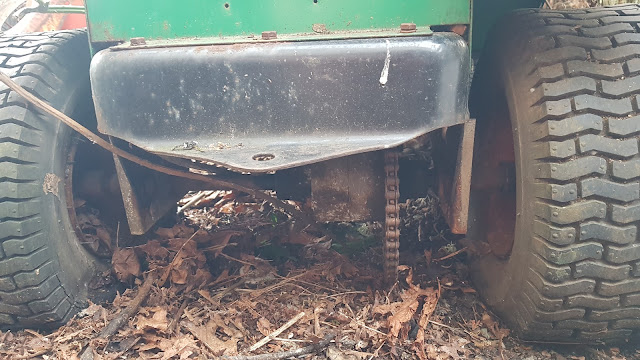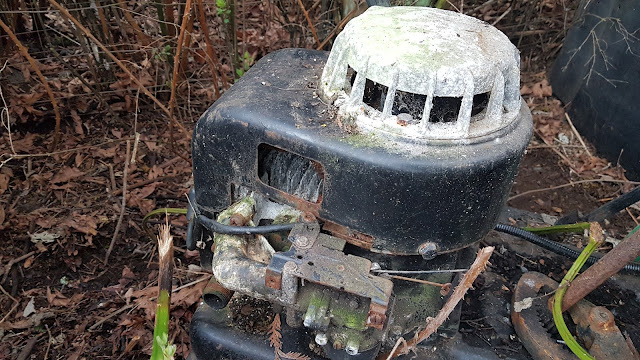Weekend 1 - Drag er outta the bushes
This mower was a project I had been meaning to get back to for almost 20 years. I purchased it when I was roughly 8-10 years old. I had accompanied my dad and my grandpa to look at a motor for my grandpas truck. The man selling the motor was selling out everything and there was this 1970s? Craftsman lawnmower, the perfect go kart for me.
We still need a new carb, but we know she runs and that's a great starting point. Unfortunately the belt blew off when we tried to get it mowing... I mean, uh... Moving, so we are gonna have to wait to test out the transmission. There's only one good tire on the front right now anyways, so we may as well put together our new steering and front tires. That's got to wait until next week though.
Weekend 2 - Front end lower & better steering
It came time to dive into the thick of modifying this mower. The stock front axle on the mower was not set up for speed. It is tall and would likely get very shaky at higher speeds. The wheels are also loose on the spindles.
I took the mower axle inside and got to work on removing the original spindles.
I used the tie rod from the same scooter I took the spindles from, and extended it using a section of the stock mower tie rod. After the new spindles and tie rod were in place, I put it back on the mower with some wheels - to see how things were looking. We used the stock wheels and tires from the same scooter I took the other steering components from.
The issue was firstly that on the mower, the arm extending from the stock spindle was pointed outward over top of the tire, and our new spindle had and arm extending inward (in behind the wheel where it belongs). This meant if we hooked up our steering this way, it would steer backwards. Secondly, it wasn't exactly pointing inwards. It was sort of sideways, and was meant to be pushed from side to side - not forwards and backwards. Oh, and thirdly, the new spindle with the arm for the steering rod to connect to was on the wrong side.
I now have a rolling chassis that has been lowered in the front a total of 3.5", adding the 4" spindle drop, and slightly larger tires. The steering is also much tighter than the original lawnmower steering, and is set up for taking corners much better. Next week I am going to put on a new belt, set up new throttle and choke cables, and see if we can get this thing moving under its own power.
Month 2 - The rear axle
Now it was time to make this thing move... or not. I wanted to change to a centrifugal clutch, and thought id just pull off the stock pulley to check the shaft size. It was seized on good! After I spent over an hour with pullers and hammers I had the stock pulley off the motor shaft. I was not about to put it back on.
The motor turns out to have a 1" shaft and unfortunately for me a 1" centrifugal clutch with a pulley is not common and would run me about $200. It was time to work on something else while I figured out the best move on this issue. Time to tackle the rear end.
There were a few tasks involving the rear end of this mower. One was to get some new tires on it since the old ones no longer held air, another was to lower it to match the front end, and since this was a race mower a smaller rear sprocket was certainly in order to get some more speed out of this thing. With that gain in speed it seemed only natural to add some stopping power somewhere (since it barely had any brakes in stock form) and upgrade the bearings.
First I pulled out the old axle and dismantled it. The stock sprocket on the rear end had 55 teeth, and it was HUGE, in fact, it was the lowest hanging part on the mower so it was best to get a smaller one on there for that reason too.
I went into my shed and was blown away to find an old mobility scooter differential that was almost identical to my mower differential. It may make a fantastic spare in the future, but for now the most interesting part was the 27 tooth sprocket attached to it. It would effectively double my speed and by the looks of it was the smallest sprocket you could fit on that diff. PERFECT! well,... almost perfect. The chain and sprocket on the old mower was a #41 and this sprocket was a #40 witch is a thicker chain and sprocket. Luckily though the two sizes share the same pitch and overall profile so all I needed to do was make this one thinner. I took it to the lathe and turned it down to the correct thickness and re-chamfered the freshly machined side. The bolt hole circle to attach it was also different so I had to drill another set of holes in it to fit the mower diff.
Next were the brakes. The axle only has a keyways on the ends for the tires to attach to so I was not going to be able to use a hub with a key. I found a brake disk from an old ebike and turned a custom aluminum hub for it.
To attach it to the axle I ground a flat spot on the axle and used a set screw in the hub to hold it in place. I bought a cheap mini bike caliper and turned down the ebike disk to fit it. Probably would have been best to just buy the matching disk with the mini bike caliper, but I'm cheap and had the means to utilize a free one.
I disassembled the differential and regreased it before reassembling with the new sprocket and brake disk.
Now it came to mounting the rear end. The original bearings were nothing more than a couple bushings with some grease so we definitely needed an upgrade. I also planned to use some narrower tires so we could now mount the new bearings a little further out to increase support for the axle and allow us to run a standard pillow block bearing. I cut two pieces of angle iron to hold the bearings and mounted them up as far as they could go.
The rear end ended up a tiny bit lower than the front but I may eventually run larger tires in the back so this is no issue and was barely noticeable. Next was to test fit the axle and figure out some spacers. It turns out the matching rear tires from the same scooter I used for the front end fit the rear axle perfectly so it seemed only natural to use them. Now I would have 4 matching rims and tires. OCD very satisfied.
For spacers we ended up finding a set of cheap bushings that worked perfectly for us. Two on each side put us almost perfectly to the end. A couple washers to take out the slack and we had it sitting on 4 wheels again, now fully lowered.
That's all for this post. Next post its time to tie this all together. Belts, Chains, clutches, pedals, cables.




























































No comments:
Post a Comment